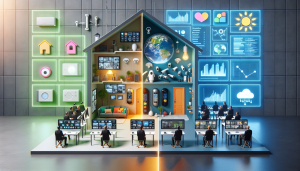Volumetric Displays: Bringing 3D Objects to Life
The world of technology is constantly evolving and pushing boundaries, with new innovations emerging every day. One such innovation that has caught the attention of tech enthusiasts is volumetric displays. Bringing 3D objects to life like never before, these displays have the potential to revolutionize the way we interact with technology. So, what exactly are volumetric displays and how do they work? Let’s dive into the world of 3D visuals and explore the magic of volumetric displays.
What are Volumetric Displays?
Volumetric displays, also known as 3D displays, are a type of display technology that creates three-dimensional images by using a combination of light projection and optics. Unlike traditional display screens that are flat and can only produce 2D images, volumetric displays allow viewers to experience objects in three dimensions, as if they were real and tangible.
The concept of volumetric displays is not new, as researchers and developers have been exploring this technology since the 1970s. However, recent advancements in display technology and the increasing demand for immersive visuals have led to significant progress in the development of volumetric displays.
How do Volumetric Displays Work?
The basic principle behind a volumetric display is to create an image using a combination of light sources, projections, and reflective surfaces. This is achieved by projecting either a series of 2D images or a full 3D volumetric model onto a rotating screen, known as the volumetric display medium.
The display medium consists of a spinning helix, a rotating cylinder, or a rapidly moving plane, and is coated with a highly reflective material. As the images or models are projected onto the medium, they are reflected and blended together, creating a 3D image that appears to be floating in mid-air.
The Potential of Volumetric Displays
Volumetric displays have the potential to transform multiple industries, with their ability to create life-like 3D images. From improving the viewing experience of video games and movies, to revolutionizing the fields of education, healthcare, and advertising, the potential uses of this technology are vast.
In the medical field, volumetric displays have the potential to assist doctors in visualizing and manipulating 3D medical scans, leading to more accurate diagnoses and improved treatments. In education, students can benefit from interactive 3D displays that make learning more engaging and immersive.
Advertisers can also harness the power of volumetric displays by creating eye-catching and dynamic 3D advertisements that capture the attention of consumers. With this technology, the possibilities are endless.
The Future of Volumetric Displays
The development of volumetric displays is still in its early stages, but the potential of this technology has grabbed the attention of major tech companies. In recent years, tech giants like Microsoft and Intel have invested in developing volumetric display technology, with Microsoft’s HoloLens and Intel’s RealSense being some notable examples.
As the technology continues to advance and become more accessible, we can expect to see more practical and widespread use of volumetric displays in various industries. With the potential to bring 3D objects to life, this technology has the capability to change the way we view and interact with the world around us.
The Final Dimension
Volumetric displays represent a new era of visual technology, bringing 3D objects to life in a way that was once just a dream. With endless potential and exciting developments on the horizon, volumetric displays have the power to change the game in multiple industries. As we continue to push the limits of technology, who knows what other groundbreaking innovations lie ahead.










